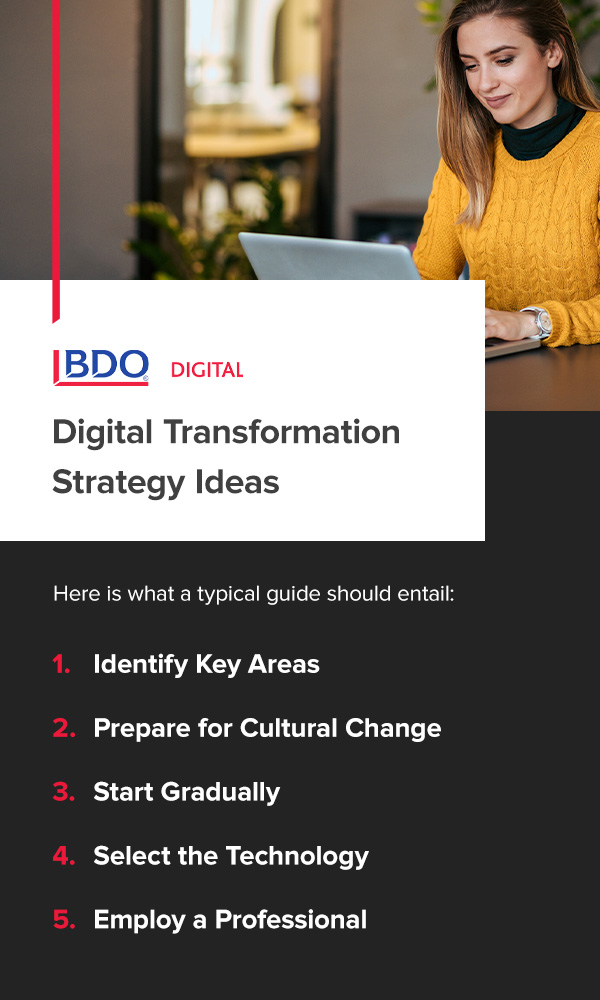What Is Digital Transformation and Why Is It Important?
What Is Digital Transformation and Why Is It Important?
Digital transformation has gained momentum in business operations, and organizations worldwide use digital tools to stay competitive by streamlining services and enhancing customer experience. Still, the concept of digital transformation can take time to fully understand, but this is crucial for executives who are focused on other areas.
This article will do three things — discuss in detail what digital transformation is, why it is essential, and how to integrate an efficient digital transformation strategy into your business.
What Is Digital Transformation?
What does digital transformation mean? Imagine running an organization with a digital tool that allows you to create new business processes, better customer experiences and culture, or modify existing models to optimize entire business operations. This integration of digital technology into every part of the business is known as digital transformation.
Corporations worldwide integrate digital technologies into every aspect of their processes to drive fundamental changes. Digital transformation is not necessarily only about upgrading your existing technology — it's much more than that. Digitally transforming your business is a continuous process deeply rooted within your brand's core strategy to create a digital-first mindset. It requires organizations to constantly challenge their status quos to find better approaches.
Understanding digital transformation requires you to have a grasp of five essential components — people, insights, data, action, and results. This helps you to know which technology to use, how to analyze data, and how to conduct operations. Identifying the correct data also makes room for proper interpretation, which guides you in taking the necessary steps for digital implementation. In the end, you can evaluate the impact of your strategy in light of your desired goals.
A digital transformation strategy is embedded in all aspects of the business, including sales, marketing, product and service distribution, finance, operation, and customer service. It enables various departments to coordinate efficiently, and the result is consistently top-quality products and services.
Overall, digital transformation makes your business resilient and flexible to accommodate the demands of the ever-changing 21st-century market.
The Background of Digital Transformation: Four Industrial Revolutions
To help you further understand how digital transformation fits into today's societal and technological growth, let us examine the four Industrial Revolutions.
The four Industrial Revolutions are periods of scientific and technological development beginning in the United Kingdom in the 18th century. Traditionally, historians referenced one Industrial Revolution, referring to the height of industrial production in the 1830s and 1840s. Now, many modern historians call this the First Industrial Revolution to set it apart from further industrial development that came after.
Almost a century later, in 1870, electricity, gas and oil began dominating industrial processes. The combustion engine was invented, natural and synthetic products entered the market, communication grew, and computers paved the way for the automatic factory. Beyond developing mechanical products, business structures also changed considerably.
Fast forward to 1969, the Third Industrial Revolution was born. Nuclear energy and electronics dominated this era. Automation became the norm and operations became digitized. The internet revolutionized the transmission of information. This era was short-lived. By 2000, the Fourth Industrial Revolution (4IR or Industry 4.0) had emerged.
The 4IR is what we are exploring now. Breakthroughs in artificial intelligence, robotics, blockchain, the Internet of Things (IoT), 3D printing, nanotechnology, biotechnology, quantum computing, and energy storage are unlocking business potentials previously thought impossible.
Top-tier companies worldwide are taking advantage of these innovations to drive efficiency and profitability and deliver value to customers — digital transformation is the secret to staying competitive. For instance, it allows organizations to redesign their supply chains to better use machine learning, adopt cloud computing to improve data management, or use digital technology to predict consumer preferences.
In 2021, a survey involving 500 C-level executives from companies with annual revenues between $100 million and $3 billion revealed that 51% of middle-market organizations are adding new digital projects to their existing structure, and 49% are revising their long-term strategic vision. Additionally, 90% of middle-market organizations planned to maintain or increase digital spending.
Digital transformation is broad. It is applicable in multiple industries, including health care, financial services, education, construction, retail, and private equity. Within each field and industry, there are tailor-made strategies to handle various aspects and completely transform operations.
How the COVID-19 Pandemic Accelerated Digital Transformation

Many companies adopted digital transformation frameworks to survive the COVID-19 pandemic. During the lockdown, the internet assisted people in completing everyday tasks like shopping, staying entertained, learning new skills, and working. This phenomenon changed how companies operated and accelerated the integration of digital technology.
Consumer behavior has shifted since the pandemic. There is an increase in streaming video content and other online activities. Customers find it convenient to shop online rather than walk into brick-and-mortar stores to make purchases. These changes in behavior have left companies no choice but to adopt digital solutions to match the shifts in demand and supply and processes to avoid being left behind.
Lest we forget, the massive increase in online operations has also increased the need for cyber security to protect individuals and businesses against cyberattacks and information breaches. IBM's Cost of a Data Breach 2022 report indicates the average cost of a data breach in the United States is $9.44 million, $5.09 million more than the global average, making digital security a necessary cost-saving measure.
Why Is Digital Transformation Important?
Spending on digital transformations is projected to reach $1.8 trillion by the end of 2022. The importance of digital transformation in businesses is evident at all operational stages — systems, workflow, processes and culture. Capturing the full power of digital technology helps your business thrive, so you do not need to play catch-up. Here are eight reasons why digital transformation is necessary:
1. Transforms Customer Experience
Customer satisfaction is at the heart of every business, and digital transformation allows you to increase your team's efficiency while delivering seamless customer service. Digital transformation improves client communication and opens doors for reaching new customers. It also allows you to offer customers quality products and services at competitive prices with a wide range of options.
Beyond that, businesses can improve delivery times regardless of the channel or place. The organizations that implement functioning digital solutions offer customers better-personalized services with improved accessibility. This way, they achieve their goals and retain customers.
2. Data-Driven Insights
Operating a business without data is like sailing without a map or compass — you will be lost at sea. Going digital helps you track metrics and analyze the captured data. Data is necessary to understand customer needs and gain insights into industry trends. This information helps companies make informed decisions.
For instance, social media metrics can help you know which demographics to target and how to reach that group. Entities can predict how customers will receive certain products and services with that information. Moreover, it guides organizations to invest in the right areas for better returns, and that will help you grow your business.
3. Increased Profit
Digital business transformation is the foundation for revenue marketing. Digital solutions reduce expenses and drive operational efficiency. Let us consider a practical example. Since Coverdell migrated to Azure, the company has witnessed a 90% decrease in time to implementation. Over a three-year period, the company also saved $1 million in web hosting costs and has reduced the risk of downtime with 99.99% availability.
Digital transformation also makes businesses scalable and improves decision-making. It helps with client attraction and retention — the same is true regarding talent acquisition. Additionally, digital transformation impacts employee engagement. Every stage of the enterprise lifecycle benefits from digital solutions, and this boosts revenue.
4. Efficient Collaboration

Businesses thrive when there are common goals with well-synchronized teams, especially when the digital culture is appropriately planned and executed. Digital tools can offer seamless communication patterns, encouraging digital coherence. Meetings are easy to organize and suitable to attend with the right software, creating an avenue for smooth operations.
5. Improved Agility
Companies can make the best use of technology to drive agility and innovation without being high-tech. A vital feature of digital transformation is flexibility. The strategy is deeply rooted in the organization's foundations, causing a shift from traditional processes to approaches that evolve with the tides of technology.
Companies must react swiftly to changing market conditions to stay relevant — that is what digital transformation brings to the table. A comprehensive and collaborative digital transformation plan helps you implement agile methodologies. These help the organization in managing uncertainties, targeting and achieving specific outcomes, mitigating risks, and enhancing accountability.
6. Improved Productivity
A notable benefit of digital transformation is it can boost business growth. Companies drive progress by making decisions based on data, providing some degree of certainty regarding the outcome. Having the appropriate tools working together can increase automation, which is an excellent way to streamline workflow. In the end, teams are enabled and empowered to be more efficient.
7. Robust Resource Management
The first step in establishing a functioning entity is identifying the resources you need to execute a particular sets of tasks. The second step is to acquire those resources. Next, the organization should utilize these resources to achieve the desired goal. The business should have a system that manages the resources and apply them in the right places to yield the best results.
Digital business transformation applications offer consolidated resource tools that target business processes' efficient performance without overlaps. It integrates the applications, software, and database into a simplified and organized unit that makes organizing and managing resources easier.
8. Enhanced Data Collection
Today's businesses have access to high volumes of data, which is crucial. Data guides businesses to create result-oriented strategies. Digital transformation does three things in this regard — expands the volume of collected data, stores them at a secured location, and optimizes data usage. Each stage requires various technologies to implement, although they can be integrated for optimal performance.
Digital Transformation Strategy Ideas

Embarking on the digital transformation journey requires a clear, comprehensive plan. Here is what a typical guide should entail:
1. Identify Key Areas
Digital transformation is necessary if you want to boost your company’s growth. The process begins with understanding what digital transformation means to your business and assessing the vital areas where you need to implement the strategy. This will help you increase your return. Again, evaluating vantage points lets you know which kind of technology you need to transform your business.
For instance, you can begin by setting short and long-term goals with identifiable timelines. Keep in mind that patience pays off. Consider your business objectives and needs before considering which technologies you need to achieve them — not the other way around. Make sure all of the necessary and relevant stakeholders are engaged at this step.
2. Prepare for Cultural Change
Most companies have retained years of tradition, which is excellent — just remember that digital transformation requires flexibility and a willingness to accept change in the right areas. The reason is simple — if a practice does not drive value and revenue to your business, you must be ready to adjust it.
Beyond that, digital transformation brings new ideas and approaches to the table. Resistance to change is natural, so it helps to prepare for what is to come. The goal is to avoid any surprises, which could make the shift even more challenging. Overall, flexibility makes room for innovation.
3. Start Gradually
It helps to start small so you can guide your company properly and work to overcome inevitable obstacles. Eventually, your organization will be ready to implement things more quickly. Digital transformation is a journey, not an event. A proof of concept can help you prepare adequately for impending challenges at this stage.
4. Select the Technology
Having a good understanding of your goals paves the way for how to achieve them. The areas you look to strengthen will determine which technology to adopt and how to use it. The available technology might fall into one of the following areas:
- Artificial intelligence and machine learning
- Cloud computing
- Robotics
- Blockchain
- IoT
- Augmented reality
These are just a few examples, and you may find that a combination of these innovations works best for your company.
5. Employ a Professional
Consider outsourcing your IT infrastructure to an expert who can provide a personalized service based on your goals. The advantages are that outsourcing increases agility, improves efficiency, simplifies compliance, and drives technological innovation. Organizations may set up and manage their own digital platforms, but engaging a partner with experience in the field and access to the right technology is how most companies succeed.
Start Your Digital Transformation Journey With BDO Digital
A digital transformation strategy is most meaningful and impactful when the organization and the partner providing the digital services work together toward achieving a common goal. The partner you choose must understand both your industry and your organization to suggest the best technological tools and how to utilize them.
At BDO Digital, we provide personalized services and place our trusted professionals behind your organization to drive success. Besides giving you access to our experienced team, we make our cutting-edge technology available to your organization, digitally transforming your business to remain competitive.
Do you want to learn more about digital transformation and how it can help your business grow? Contact us today!


SHARE